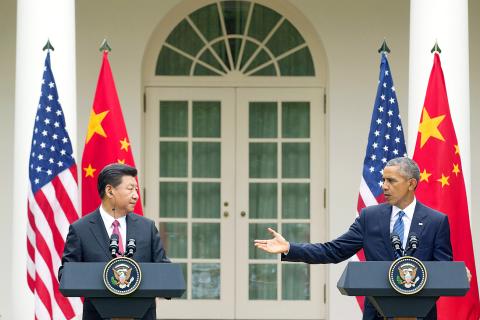The US on Friday announced agreements with China on a military hotline and rules of behavior to govern air-to-air encounters, just days after the Pentagon criticized China over an unsafe intercept of a US reconnaissance aircraft.
The agreements were unveiled following talks in Washington between Chinese President Xi Jinping (習近平) and US President Barack Obama, and seek to lessen the chance of an accidental flare-up between the two militaries, despite tensions in the South China Sea.
“We agreed to new channels of communication to reduce the risks of miscalculations between our militaries,” Obama told a White House news conference, with Xi standing beside him.

Photo: EPA
The new agreement on rules of behavior for air-to-air encounters was broad in scope, addressing everything from the correct radio frequencies to use during distress calls to the wrong physical behaviors to use during crises.
“Military aircrew should refrain from the use of uncivil language or unfriendly physical gestures,” read one provision of the agreement.
Another agreement created formal rules to govern use of a military crisis hotline, a move that aims to enhance top-level communication.
The Pentagon says two Chinese JH-7 fighter jets intercepted a US RC-135 reconnaissance airplane, with one fighter passing within just 150m of the US aircraft. The intercept took place on Sept. 15, about 130km east of the Shandong Peninsula in the Yellow Sea.
The Pentagon reported a far more dangerous intercept in August last year, when a Chinese warplane flew as close as 7m to 10m to a US Navy patrol jet and conducted a barrel roll over the airplane.
One US defense official said the US will expect “full compliance” with the agreement.
The intercepts are examples of moves seen as an assertion of the expanding reach of China’s military. This month, five Chinese People’s Liberation Army Navy ships sailed in the Bering Sea off Alaska.
Closer to home, China’s territorial claims have stoked tensions. Beijing claims most of the South China Sea, through which US$5 trillion in ship-borne trade passes every year.
Obama expressed concerns about Chinese militarization of artificial islands in the South China Sea to Xi, but Xi denied any plan to establish military strongholds there.
“I conveyed to President Xi our significant concerns over land reclamation, construction and the militarization of disputed areas, which makes it harder for countries in the region to resolve disagreements peacefully,” Obama said.
China has said repeatedly that the artificial islands it has built up on disputed reefs would be used for military defense and analysts say satellite pictures show it has completed one military-length runway and appears to be working on two more.
US Pacific Command head US Navy Admiral Harry Harris told the Aspen Security Forum in July that China was building hangers on one of the reefs that appeared to be for tactical fighter aircraft.
However, Xi denied that militarization was taking place.
“Relevant construction activity that China is undertaking in the Nansha Islands (南沙群島) does not target or impact any country and there is no intention to militarize,” Xi said, using the Chinese name for the disputed Spratly Islands, which are also claimed in whole or in part by Taiwan, Vietnam, Brunei, Malaysia and the Philippines.
“Islands in the South China Sea since ancient times are Chinese territory,” Xi said. “We have the right to uphold our own territorial sovereignty and lawful legitimate maritime rights and interests.”
Xi also reiterated that China is committed to freedom of navigation in the sea and to resolving disputes through dialogue.
He said Beijing and Washington had a shared interest in this regard.
Washington analysts and US officials say the militarization of the islands has already begun and the only question is how much military hardware China will install.
US experts say satellite photographs from early this month also show China was carrying out dredging work around the artificial islands, a month after saying it had stopped.
Harris last week said that China’s runway building and further militarization of the artificial islands was of “great concern” and posed a threat to all countries in the region.

Auckland rang in 2026 with a downtown fireworks display launched from New Zealand’s tallest structure, Sky Tower, making it the first major city to greet the new year at a celebration dampened by rain, while crowds in Taipei braved the elements to watch Taipei 101’s display. South Pacific countries are the first to bid farewell to 2025. Clocks struck midnight in Auckland, with a population of 1.7 million, 18 hours before the famous ball was to drop in New York’s Times Square. The five-minute display involved 3,500 fireworks launched from the 240m Sky Tower. Smaller community events were canceled across New Zealand’s

The Ministry of Foreign Affairs (MOFA) yesterday said it is closely monitoring developments in Venezuela, and would continue to cooperate with democratic allies and work together for regional and global security, stability, and prosperity. The remarks came after the US on Saturday launched a series of airstrikes in Venezuela and kidnapped Venezuelan President Nicolas Maduro, who was later flown to New York along with his wife. The pair face US charges related to drug trafficking and alleged cooperation with gangs designated as terrorist organizations. Maduro has denied the allegations. The ministry said that it is closely monitoring the political and economic situation

UNRELENTING: China attempted cyberattacks on Taiwan’s critical infrastructure 2.63 million times per day last year, up from 1.23 million in 2023, the NSB said China’s cyberarmy has long engaged in cyberattacks against Taiwan’s critical infrastructure, employing diverse and evolving tactics, the National Security Bureau (NSB) said yesterday, adding that cyberattacks on critical energy infrastructure last year increased 10-fold compared with the previous year. The NSB yesterday released a report titled Analysis on China’s Cyber Threats to Taiwan’s Critical Infrastructure in 2025, outlining the number of cyberattacks, major tactics and hacker groups. Taiwan’s national intelligence community identified a large number of cybersecurity incidents last year, the bureau said in a statement. China’s cyberarmy last year launched an average of 2.63 million intrusion attempts per day targeting Taiwan’s critical

‘SLICING METHOD’: In the event of a blockade, the China Coast Guard would intercept Taiwanese ships while its navy would seek to deter foreign intervention China’s military drills around Taiwan this week signaled potential strategies to cut the nation off from energy supplies and foreign military assistance, a US think tank report said. The Chinese People’s Liberation Army (PLA) conducted what it called “Justice Mission 2025” exercises from Monday to Tuesday in five maritime zones and airspace around Taiwan, calling them a warning to “Taiwanese independence” forces. In a report released on Wednesday, the Institute for the Study of War said the exercises effectively simulated blocking shipping routes to major port cities, including Kaohsiung, Keelung and Hualien. Taiwan would be highly vulnerable under such a blockade, because it